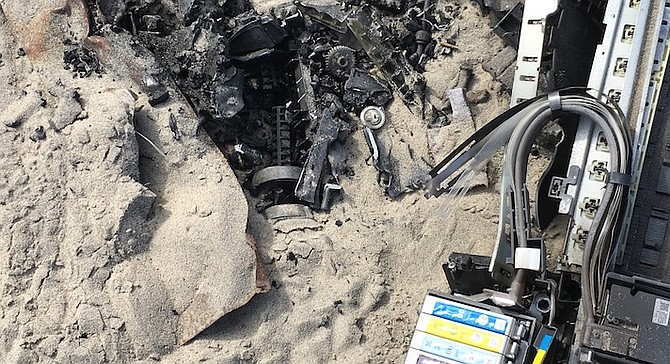 Facebook
Facebook
 X
X
 Instagram
Instagram
 TikTok
TikTok
 Youtube
Youtube

Fire pits at South Mission Beach are heating up again.
Residents complain that smoke blown on the wind is polluting their homes. It comes not only from the permitted burning of wood and paper but from rubber and plastic. Couches and a printer are some of the other items that have been found in the pits the morning after.
In 2014, Nancie Geller and Betty Jean Lundquist researched and wrote “Fire Pits on Mission Beach,” a report on the how the burning affects people’s health. The report found that poisonous chemicals, dioxins and formaldehyde, for example, travel in the fumes.
Even the pallets that are popular fuel in the pits violate the rules because of nails and the treated wood they contain. The varnish on the old furniture that often appears in the pits is also dangerous when burned.
Residents who live on the boardwalk receive the most intense blown smoke.
“Anybody who is already compromised by lung problems, such as asthma and bronchitis, or cardiac issues, is at high risk,” says Geller on the day before the Fourth of July.
It has been hard enough to control what goes on at the permanently positioned fire pits. South Mission Beach has eight of them, plus four more along the jetty just outside the gate at the edge of the parking lot.
A relatively new dynamic is now complicating the picture. Several companies rent portable fire pits along with other amenities, such as plastic chairs for sitting around the fire. They might even supply the s’mores for browning that many people insist is the key ingredient in the enjoying of friends around the fire. These companies set up much closer to the boardwalk than where the concrete pits are located.
Dan Daneri, district manager of the city Parks and Recreation beaches and coastal parks, says it is almost most impossible to stop this practice, despite its violation of the rules.
“I have four park rangers to cover the shoreline from Sunset Cliffs to Torrey Pines,” he says.
Neither of two companies contacted, San Diego Coast Rentals and Beach Fire Guy, answered phone inquiries as to whether they have licenses to set up fire pits on the beach.
There are no such licenses, says Daneri.
South Mission has staunch defenders of the fire pits, too. Some see them as the prime attraction to tourists who visit San Diego’s beaches. In 2008, at a time when the city came close to defunding maintenance of the pits, a $259,500 donation was received from an anonymous donor to keep them. Councilman Kevin Faulconer ($16,452) and several private organizations kicked in more money, and the pits were saved.
Sitting around a beach fire with family creates lasting memories, says Geller. “I get that. But something has to be done to protect residents.”


Fire pits at South Mission Beach are heating up again.
Residents complain that smoke blown on the wind is polluting their homes. It comes not only from the permitted burning of wood and paper but from rubber and plastic. Couches and a printer are some of the other items that have been found in the pits the morning after.
In 2014, Nancie Geller and Betty Jean Lundquist researched and wrote “Fire Pits on Mission Beach,” a report on the how the burning affects people’s health. The report found that poisonous chemicals, dioxins and formaldehyde, for example, travel in the fumes.
Even the pallets that are popular fuel in the pits violate the rules because of nails and the treated wood they contain. The varnish on the old furniture that often appears in the pits is also dangerous when burned.
Residents who live on the boardwalk receive the most intense blown smoke.
“Anybody who is already compromised by lung problems, such as asthma and bronchitis, or cardiac issues, is at high risk,” says Geller on the day before the Fourth of July.
It has been hard enough to control what goes on at the permanently positioned fire pits. South Mission Beach has eight of them, plus four more along the jetty just outside the gate at the edge of the parking lot.
A relatively new dynamic is now complicating the picture. Several companies rent portable fire pits along with other amenities, such as plastic chairs for sitting around the fire. They might even supply the s’mores for browning that many people insist is the key ingredient in the enjoying of friends around the fire. These companies set up much closer to the boardwalk than where the concrete pits are located.
Dan Daneri, district manager of the city Parks and Recreation beaches and coastal parks, says it is almost most impossible to stop this practice, despite its violation of the rules.
“I have four park rangers to cover the shoreline from Sunset Cliffs to Torrey Pines,” he says.
Neither of two companies contacted, San Diego Coast Rentals and Beach Fire Guy, answered phone inquiries as to whether they have licenses to set up fire pits on the beach.
There are no such licenses, says Daneri.
South Mission has staunch defenders of the fire pits, too. Some see them as the prime attraction to tourists who visit San Diego’s beaches. In 2008, at a time when the city came close to defunding maintenance of the pits, a $259,500 donation was received from an anonymous donor to keep them. Councilman Kevin Faulconer ($16,452) and several private organizations kicked in more money, and the pits were saved.
Sitting around a beach fire with family creates lasting memories, says Geller. “I get that. But something has to be done to protect residents.”
Comments